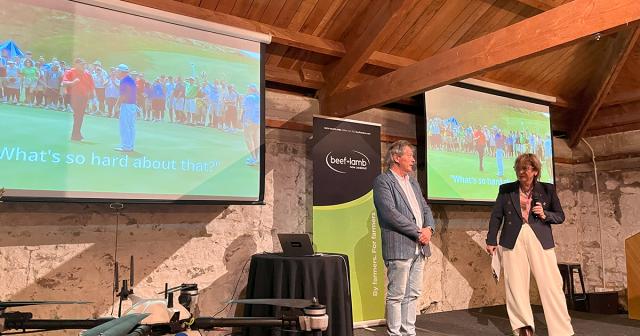Remain curious and go for it. This is what Sir Ian Taylor told a packed audience at Beef + Lamb New Zealand’s Tech over Tucker dinner held in Timaru last week.

As guest speaker, Sir Ian Taylor set the scene by saying that technology will play an intrinsic part in the future of agriculture, and he encouraged farmers to embrace curiosity.
He believes NZ has the opportunity to lead the world in addressing climate change and sustainable food production, but the country needed a shared vision.
“We need to stop yelling at each other and work out a shared vision for the country. We have to have a vision and grow that GDP.”
Organised by B+LNZ’s Central South Island Extension Manager Hannah Brewer and Extension Coordinator Cherise McPherson, the evening gave farmers a taste of some of the cutting-edge technologies available to help drive productivity and profitability in their businesses.
B+LNZ also took the opportunity to introduce Bella, the organisation’s AI tool, just ahead of its official launch this week.
Sir Ian described how he had built his business, Animation Research Ltd, turning digital data into pictures people could understand, starting with the ground-breaking graphics used in the 1992 America’s Cup.
While his company, which is a world leader in tech innovation, didn’t turn a profit for 19 years, he said they had a lot of fun along the way.
“You’ve got to enjoy it, as long as you’re making enough money to pay the bills.”
“In anything you do, you need to think about how they (your customers) want it, where they want it and when they want it.”
Talking about AI, Sir Ian said the genie was out of the bottle and people had to make it work for them.
AgResearch scientist Dr Robyn Dynes was the MC for the evening, and she led a panel discussion with three farmers who use technology in their businesses, The discussion highlighted the diverse nature of technologies available in the agricultural sector.
Windwhistle farmer David Harper outlined how they use wearable collars, in conjunction with EID, to collect data on the performance of mixed-age ewes, which then informs their decision-making when selecting replacement ewe lambs.
He said they had always been interested in technology, but when they began finishing lambs for Lumina Lamb, they started to do a lot more monitoring and collecting data to help them add value and produce a more consistent product.
While they are only running 600 breeding ewes and 300 hoggets, they wanted to reduce wastage and make these animals as efficient as possible. To do this, they have invested in Smart Shepherd technology. Proximity collars are placed on ewes and lambs for 48 hours before weaning and this helps determine which lambs belong to which ewes.
They only retain replacements from ewes that have scanned and reared twins and regained body condition by weaning.
Using data from the proximity collars as well as weaning weights, Smart Shepherd generates a list of ewe lambs that would be suitable for retaining.
David says they have used the system for four years and have seen a marked improvement in the performance of their two-tooths.
They have increased the number of lambs weaned by 18 percent, increased their average weaning weight by 7 percent and achieved a 26 percent lift in productivity.
South Canterbury farmer and businessman William Rolleston told the audience that when he was President of Federated Farmers, he was asked to do a presentation on Drones in NZ Agricultural at an international conference – despite knowing nothing about the subject.
This led him on a journey of discovery and eventually the purchase of aerial robotics company Aeronavics which he and his brother John subsequently moved from Hamilton to Timaru.
Aeronavics designs and builds drones while the brothers’ other company, SPS Automation, automates the drones.
Unlike standard drones, their “Agri-copters”, can carry 15 litres of chemical and are run by a combustion engine rather than a battery; this enables them to fly for an hour rather than eight to 10 minutes.
William said their CAA licence allows their drones to be flown outside of line of sight and use swarm technology, which means they will be able to operate a fleet of drones to carry out operations such as the control of wilding pines, gorse and other weeds.
William said they use AI to identify target species, spray and then record the action.
They envisage running an ecosystem of autonomous robotic technology with drones operated from a central location, all linked through Starlink.
They are also in the throes of developing drones with payloads of 50kg and 250kg.
Greg Coppell from Repost was the third speaker on the panel and he described how necessity was the mother of invention when he and his wife Dansy were developing their sheep and beef farm near St Arnaud.
They saw the opportunity to turn waste posts from the wine industry into low-cost fence posts.
So began an award-winning business which is a win: win for the viticulture industry, sheep and beef farmers and the environment.
In the past five years, they have repurposed over one million vineyard posts that would otherwise have gone to landfill, and donated fence posts to farmers affected by recent major weather events.
Following this theme, B+LNZ’s South Canterbury Farming for Profit committee is running a demonstration field day at Cave on 12 September. It’s an opportunity to see drones and other technologies in action. See the events page on B+LNZ’s website for more information.
Tech over Tucker was sponsored by B+LNZ, South Canterbury Rural Support Trust and South Canterbury Toyota.